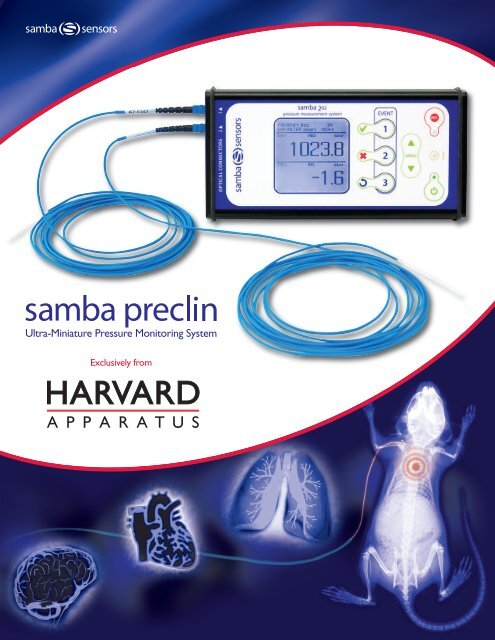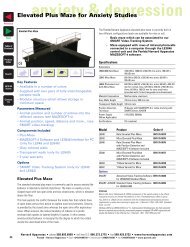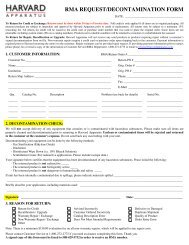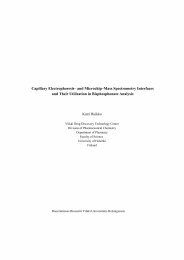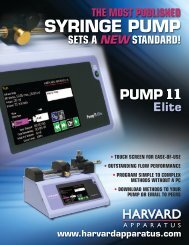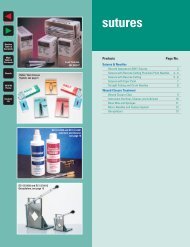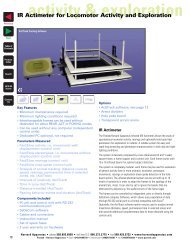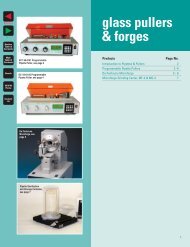Ultra-Miniature Pressure Monitoring System - Harvard Apparatus UK
Ultra-Miniature Pressure Monitoring System - Harvard Apparatus UK
Ultra-Miniature Pressure Monitoring System - Harvard Apparatus UK
Create successful ePaper yourself
Turn your PDF publications into a flip-book with our unique Google optimized e-Paper software.
<strong>Ultra</strong>-<strong>Miniature</strong> <strong>Pressure</strong> <strong>Monitoring</strong> <strong>System</strong><br />
Exclusively from
Measurements with<br />
exciting opportunities<br />
Just imagine the exciting things you can<br />
do with an extremely accurate, fast<br />
sampling, pressure sensor that is no<br />
bigger than a grain of salt on a human hair. Exciting<br />
opportunities open in all kinds of life science applications.<br />
0.25 mm<br />
0.42 mm<br />
<strong>Monitoring</strong> More Straightforward Than Ever<br />
With a Samba Preclin transducer, intravascular blood pressure<br />
(IBP) and left ventricular pressure (LVP) monitoring become more<br />
straightforward than ever. Inserted through the carotid or<br />
fermoral artery, you can receive accurate, high resolution data<br />
to support your discoveries. Read, for example, how Chiba<br />
University in Japan used Samba Sensor’s in their research on<br />
myocardial infarction in Nature Medicine Vol. 11, No. 3, 2005. 1<br />
<strong>Pressure</strong> Patterns Never Observed Before!<br />
The small size allows you to insert the sensor directly into the<br />
brain tissue or in the brain ventricles and measure very rapid<br />
trauma events. The extremely fast sampling rate and sensitivity<br />
enable you to see pressure patterns never observed before. A<br />
perfect example of these possibilities can be found in an article<br />
in European Journal of Neuroscience Vol. 21, No. 10, 2005. 2<br />
Insensitive to all Electro-Magnetic Fields<br />
Samba Preclin offers exciting opportunities when using MRIscanners.<br />
The sensor gives you total freedom to monitor<br />
pressure while simultaneously capturing images in the latest<br />
high-end scanners. Gating also becomes more reliable and<br />
robust with the Samba Preclin transducer. If placed in the tail<br />
artery of a rat, both IBP and respiratory signals can be captured<br />
using a single sensor (see chart to the right).<br />
Why Samba Preclin<br />
• <strong>Pressure</strong> can be measured with higher precision and in<br />
places previously not possible.<br />
• Continuous pressure data can be retrieved in real time during<br />
MRI/CT/ PET/SPECT scanning.<br />
• A new tool to facilitate scientific work and improve results.<br />
• New science and knowledge can be revealed leading to<br />
breakthrough publications.<br />
Where to use<br />
Samba Preclin<br />
Preclinical Research<br />
in the Area of:<br />
• Heart and Circulation<br />
• Brain and Nervous <strong>System</strong><br />
• Lungs and Breathing<br />
• Digestive <strong>System</strong><br />
• Muscles<br />
• Kidney and Urinary <strong>System</strong><br />
• Reproduction <strong>System</strong><br />
• Diseases: Cancers, Stroke,<br />
Spinal Disorders & more<br />
Rat Tail Artery IBP During MRI Scanning (500 Hz samping rate)<br />
B. Bjelke, MD, PhD. Karolinska Institute, Stockholm, Sweden 2003.
One/Two Fiber Optic<br />
Ports (201, 202)<br />
Battery Operation<br />
Internal Data Storage<br />
USB 2.0 Data Interface<br />
Analog Output (x2)<br />
Digital In/Out<br />
RS-232 Data Ports<br />
Power Inlet<br />
Internal Barometer<br />
81 mm (3.2 in) Display<br />
Intuitive User<br />
Interface<br />
Sensor<br />
Low <strong>Pressure</strong>: Diam. 0.42 mm<br />
High <strong>Pressure</strong>: Diam. 0.36 mm<br />
How to use Samba Preclin<br />
The primary feature is the miniature size: 0.36 or 0.42 mm<br />
depending on the version. The transducer can be smoothly<br />
inserted into tiny organs or tissues with minimal tissue trauma.<br />
Once in place, the transducer will not affect the actual<br />
environment it is set to measure. The Samba Preclin transducer<br />
is also safe, meaning that no electricity and no bio-hazardous<br />
materials are involved. It is also insensitive to any form of<br />
electro-magnetic fields to make it fully compatible with highend<br />
imaging technologies such as MR, CT, PET and SPECT. If<br />
scanner triggering is desired the blood pressure signal can be<br />
used in favor of ECG to further increase image quality.<br />
Optical Fiber<br />
Diam. 0.25 mm<br />
Ref. 1: Harada M et. al., “G-CSF prevents cardiac remodeling after<br />
myocardial infarction by activating the Jak-Stat pathway in cardiomyocytes”,<br />
Nature Medicine, Vol.11, No. 3, pp. 305-311, 2005.<br />
Ref. 2: Krave U et. al., “Transient, powerful pressures are generated<br />
in the brain by a rotational acceleration impulse to the head”,<br />
European Journalof Neuroscience. Vol. 21, No. 10,<br />
pp. 2876-82, 2005.
420/360 <strong>Pressure</strong> Transducers<br />
The Samba Preclin pressure transducer is comprised of a silicon<br />
sensor element mounted on an optical fiber. Each transducer is<br />
calibrated at the factory before delivery to eliminate the need for<br />
customer calibration. The calibration data is stored on a small<br />
EPROM positioned on the connector which is read automatically at<br />
start-up– simply zero the baseline and begin recording.<br />
Technical Specifications<br />
Sensor Diameter<br />
Fiber Diameter<br />
Calibration<br />
Measurement Media<br />
Tolerated Bend Radius<br />
Available <strong>Pressure</strong> Ranges:<br />
Low <strong>Pressure</strong><br />
High <strong>Pressure</strong> I<br />
High <strong>Pressure</strong> II<br />
High <strong>Pressure</strong> III<br />
Accuracy -50 to 350 mbar<br />
Accuracy -0.1 to 5 bar<br />
0.36 mm (1.1 F; high pressure) 0.42 mm (1.3 F; low pressure)<br />
0.25 mm (0.75 F), incl. standard coating 0.40 mm (1.2 F), incl.<br />
radiopaque coating<br />
Factory calibration (on-site calibration not needed)<br />
Fluid or gas<br />
10 mm (0.4 in)<br />
-50 to 350 mbar (-37.5 to 262.5 mmHg)<br />
-0.1 to 5 bar<br />
-0.1 to 10 bar<br />
-0.1 to 17 bar<br />
±0.5 mbar and ±2.5% of reading (-50 to 250 mbar)<br />
or ±4% of reading (250 to 350 mbar)<br />
±10 mbar and ±2.5% of reading (-0.1 to 3 bar)<br />
or ±10 mbar and ±3% of reading (3 to 5 bar)<br />
Accuracy -0.1 to 10 bar<br />
Accuracy -0.1 to 17 bar<br />
Temperature Coefficient -50 to 350 mbar<br />
Temperature Coefficient -0.1 to 5 bar<br />
Temperature Coefficient -0.1 to 10 bar<br />
Temperature Coefficient -0.1 to 17 bar<br />
Long Term Stability<br />
Storage Temperature<br />
Total Transducer Length<br />
Standard Bare Fiber Length<br />
Standard Length of Loose PTFE Tubing<br />
Coating<br />
±15 mbar and ±2.5% of reading (-0.1 to 6 bar)<br />
or ±15mbar and ±3% of reading (6 to 10 bar)<br />
±20 mbar and ±2.5% of reading (-0.1 to 10 bar)<br />
or ±20mbar and ±3% of reading (10 to 17 bar)<br />


